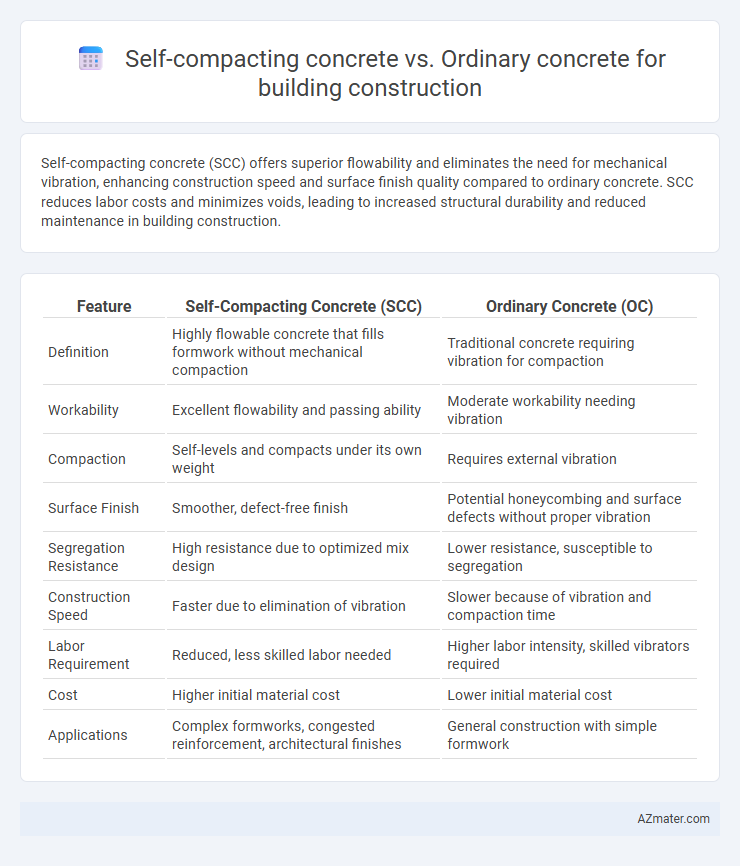Self-compacting concrete (SCC) offers superior flowability and eliminates the need for mechanical vibration, enhancing construction speed and surface finish quality compared to ordinary concrete. SCC reduces labor costs and minimizes voids, leading to increased structural durability and reduced maintenance in building construction.
Table of Comparison
| Feature | Self-Compacting Concrete (SCC) | Ordinary Concrete (OC) |
|---|---|---|
| Definition | Highly flowable concrete that fills formwork without mechanical compaction | Traditional concrete requiring vibration for compaction |
| Workability | Excellent flowability and passing ability | Moderate workability needing vibration |
| Compaction | Self-levels and compacts under its own weight | Requires external vibration |
| Surface Finish | Smoother, defect-free finish | Potential honeycombing and surface defects without proper vibration |
| Segregation Resistance | High resistance due to optimized mix design | Lower resistance, susceptible to segregation |
| Construction Speed | Faster due to elimination of vibration | Slower because of vibration and compaction time |
| Labor Requirement | Reduced, less skilled labor needed | Higher labor intensity, skilled vibrators required |
| Cost | Higher initial material cost | Lower initial material cost |
| Applications | Complex formworks, congested reinforcement, architectural finishes | General construction with simple formwork |
Introduction to Self-Compacting Concrete and Ordinary Concrete
Self-compacting concrete (SCC) is a high-performance concrete that flows under its own weight, filling formwork without the need for mechanical vibration, making it ideal for complex shapes and densely reinforced structures. Ordinary concrete requires vibration to achieve compaction and may result in voids and honeycombing if not properly consolidated, impacting durability and strength. SCC's advanced mix design enhances workability, reduces construction time, and improves surface finish compared to traditional ordinary concrete used in conventional building construction.
Key Properties and Composition Differences
Self-compacting concrete (SCC) distinguishes itself from ordinary concrete by its high flowability, allowing it to fill complex formworks without mechanical vibration, thanks to a balanced mix of fine particles, superplasticizers, and viscosity-modifying admixtures. Ordinary concrete relies on a conventional aggregate composition with lower fine content and requires vibration to eliminate air pockets and achieve compaction. Key properties of SCC include improved workability, reduced segregation, and enhanced surface finish, whereas ordinary concrete emphasizes strength achieved through proper compaction and curing.
Workability and Placement Efficiency
Self-compacting concrete (SCC) offers superior workability compared to ordinary concrete, allowing it to flow easily into complex formworks without the need for mechanical vibration. The high fluidity of SCC enhances placement efficiency by reducing labor time and minimizing the risk of segregation and honeycombing in structural elements. Ordinary concrete requires vibration for compaction, which can increase construction time and decrease overall placement efficiency in intricate or congested reinforcement scenarios.
Strength Characteristics and Performance
Self-compacting concrete (SCC) exhibits superior compressive strength and enhanced durability compared to ordinary concrete due to its uniform mixture and improved workability, which reduces voids and segregation. SCC's high flowability ensures better filling of complex formworks and congested reinforcement, resulting in consistent density and improved bond strength. Ordinary concrete, while cost-effective, often requires vibration to achieve adequate compaction, making it prone to honeycombing and lower strength performance in intricate structures.
Applications in Building Construction
Self-compacting concrete (SCC) is extensively used in complex architectural designs and densely reinforced structures due to its superior flowability and ability to fill intricate formworks without mechanical vibration. Ordinary concrete remains prevalent in standard construction projects where straightforward formwork and lower precision are sufficient, offering cost efficiency and ease of use. SCC enhances construction speed and surface finish quality, making it ideal for high-rise buildings, bridges, and precast elements, whereas ordinary concrete suits foundations, pavements, and basic structural components.
Durability and Longevity
Self-compacting concrete (SCC) exhibits superior durability compared to ordinary concrete due to its high workability, reduced porosity, and enhanced resistance to segregation and bleeding, which collectively minimize the infiltration of harmful agents and corrosion of reinforcement. SCC's dense microstructure significantly improves longevity in aggressive environments, such as exposure to chlorides, sulfates, and freeze-thaw cycles, leading to lower maintenance costs over the building's lifespan. In contrast, ordinary concrete often requires more compaction efforts and may develop voids that compromise structural integrity and accelerate degradation.
Cost Analysis and Economic Considerations
Self-compacting concrete (SCC) typically incurs higher initial material costs compared to ordinary concrete due to specialized admixtures and mix design requirements. However, SCC reduces labor expenses and accelerates construction timelines by eliminating the need for vibration, resulting in overall cost savings in large-scale projects. Economic considerations favor SCC when factoring in improved durability, reduced rework, and faster project completion, which enhance long-term return on investment.
Environmental Impact and Sustainability
Self-compacting concrete (SCC) significantly reduces environmental impact by minimizing the need for mechanical vibration, leading to lower energy consumption and noise pollution on construction sites. SCC's enhanced flowability allows for the incorporation of recycled materials and supplementary cementitious materials like fly ash and slag, which decrease cement demand and associated CO2 emissions compared to ordinary concrete. The increased durability and reduced permeability of SCC contribute to longer-lasting structures, supporting sustainability goals by reducing repair frequency and resource use over the building's lifespan.
Challenges and Limitations
Self-compacting concrete (SCC) presents challenges such as higher material costs and sensitivity to mix design variations, leading to potential segregation or reduced strength if improperly proportioned. Ordinary concrete demands extensive vibration for compaction, causing labor-intensive processes and inconsistent density in complex formworks. Both types face limitations in shrinkage control and durability under aggressive environmental conditions, impacting long-term structural performance.
Choosing the Right Concrete for Your Project
Self-compacting concrete (SCC) offers superior flowability and eliminates the need for vibration, making it ideal for complex formworks and congested reinforcement in building construction. Ordinary concrete requires mechanical compaction, which can lead to variability in density and surface finish, impacting structural durability and aesthetics. Selecting SCC enhances construction speed, reduces labor costs, and improves overall structural quality, especially in projects demanding precision and high-performance concrete.

Infographic: Self-compacting concrete vs Ordinary concrete for Building construction
 azmater.com
azmater.com